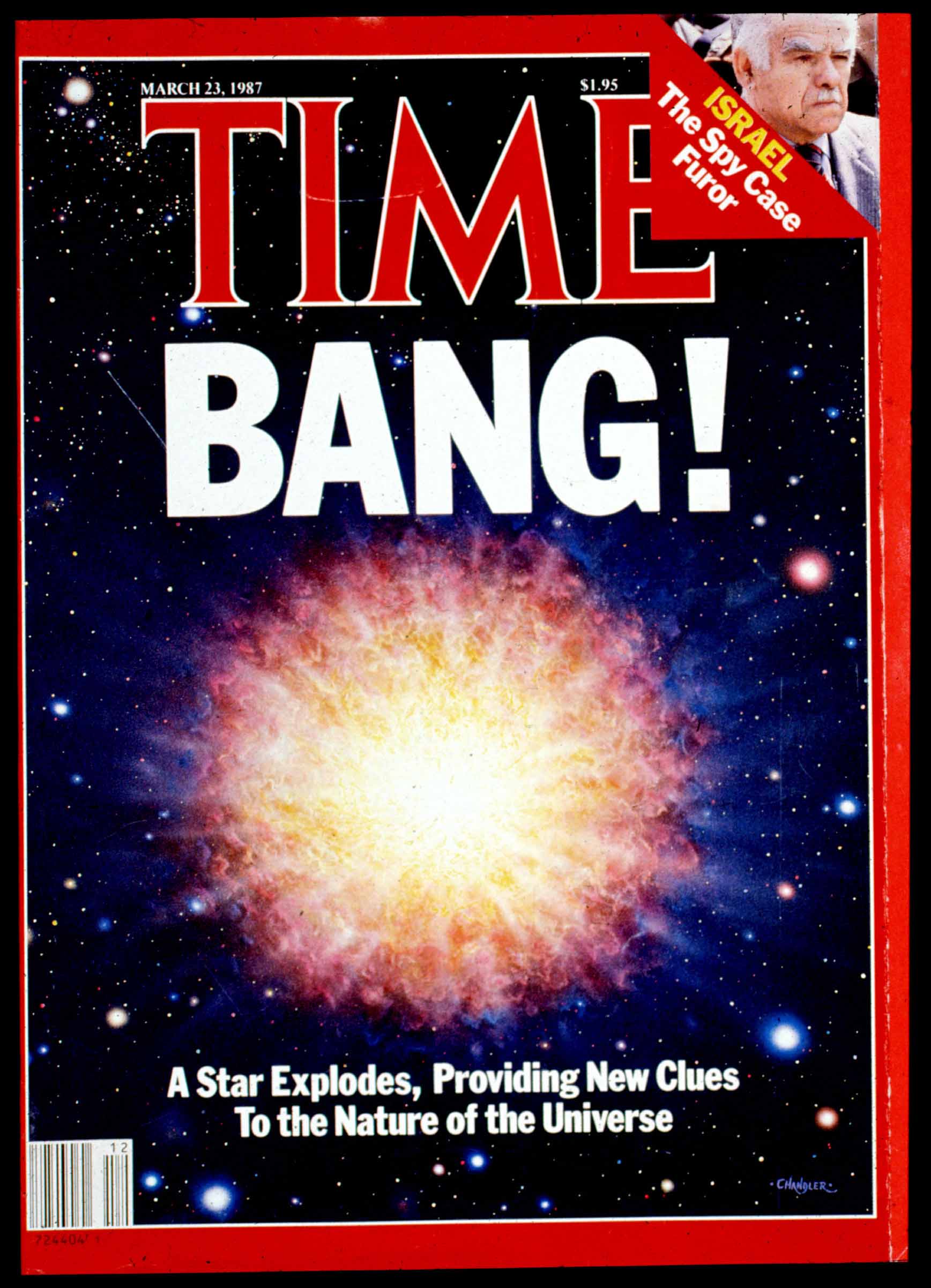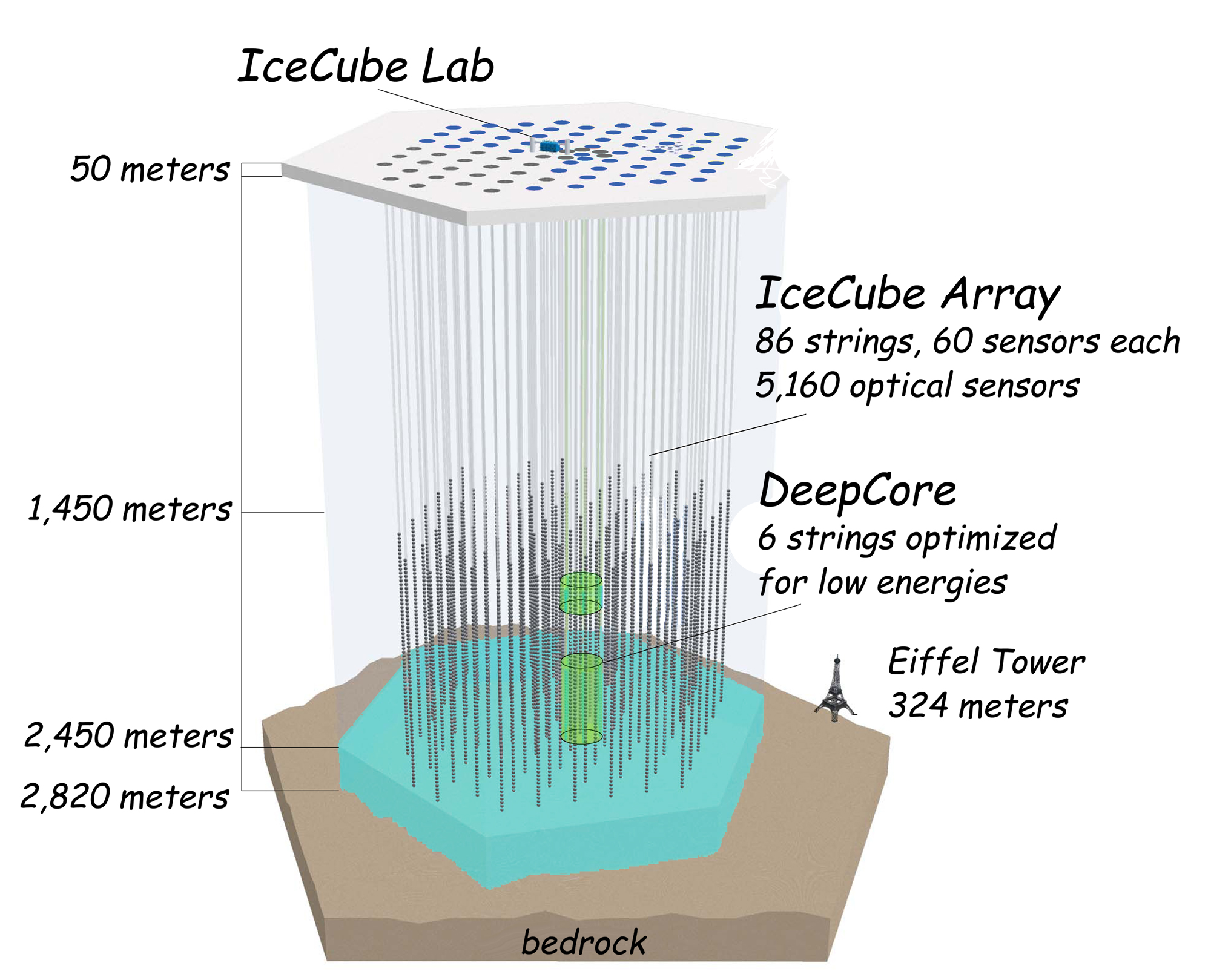Yet no one noticed.
That is, until Masatoshi Koshiba and his team inspected the data from their Kamiokande II neutrino telescope. Soon it became clear that the American IMB and the Russian Baksan neutrino observatories had detected a signal with the same time stamp: 7:36 GMT.
 Three hours later astronomers observed thru their optical telescopes a new star flaring up in the Large Magellan Cloud. The star continued to increase in brightness, and despite its mind-blowing 170,000 light years distance from earth, the star quickly became visible to the human eye. A supernova explosion had heralded the birth of a neutron star. And for the very first time, humans had directly observed the ultimate armageddon: a core collapse taking place deep inside an imploding giant star.
Three hours later astronomers observed thru their optical telescopes a new star flaring up in the Large Magellan Cloud. The star continued to increase in brightness, and despite its mind-blowing 170,000 light years distance from earth, the star quickly became visible to the human eye. A supernova explosion had heralded the birth of a neutron star. And for the very first time, humans had directly observed the ultimate armageddon: a core collapse taking place deep inside an imploding giant star.
It became evident that supernova neutrinos provide us with a direct view on the inside of imploding stars. Neutrinos fly from the core to the stellar surface and out into the universe, all along not noticing their environment is anywhere different from vacuum. This in contrast to the light from supernovas that constitutes a much more indirect signal. Supernova light gets emitted from the stellar surface once the energy from the core collapse reaches this surface. The very fact that supernova photons are delayed and spread out over weeks rather than seconds, is what had prevented us from observing the true nature of a supernova.
By mastering neutrino detection, mankind had mastered true Superman vision. With the availability of neutrino telescopes we have the capability to peek inside distant stars. Exactly twenty five years ago, an entirely new window to the universe got opened. And over the course of twenty five years, neutrino astronomy has become big business. Quite literally, in fact.
Size Does Matter
Since that memorable day 25 years ago, ever increasing amounts of tax money got poured into neutrino astronomy. Larger and larger neutrino telescopes were designed and build. Where the Kamiokande team at that time had available the world's largest neutrino detector weighing in at 3 kilotonnes (3 million kilogram, about 17 times the mass of the largest known animal to have ever existed), more recent detectors dwarf this figure. The latest neutrino telescope, IceCube completed a year ago, sports a gargantuan one million kilotonne detector (yes, that is six million blue whales, quite a few more than currently roam the oceans).Why these enormous sizes?
 Neutrinos are stealth particles. They carry no electric charge and hardly interact with ordinary matter. And that is an understatement. In order to stand a chance to get a neutrino to react or even to transfer just some of its energy, you would need to line up several hundred thousand earths on the path of that neutrino. With neutrino interactions being that rare, the number of neutrino events detected from a distant source such as a supernova will be tiny and directly proportional to the detector volume. To put this into perspective, consider the neutrino counts that characterize the supernova event twenty five years ago. Every square foot of earth got penetrated by a blast of 100,000,000,000,000 neutrinos. Despite this tsunami of neutrinos flooding earth, the combined volumes of Kamiokande II, IMB and Baksan observed no more than 25 neutrinos.
Neutrinos are stealth particles. They carry no electric charge and hardly interact with ordinary matter. And that is an understatement. In order to stand a chance to get a neutrino to react or even to transfer just some of its energy, you would need to line up several hundred thousand earths on the path of that neutrino. With neutrino interactions being that rare, the number of neutrino events detected from a distant source such as a supernova will be tiny and directly proportional to the detector volume. To put this into perspective, consider the neutrino counts that characterize the supernova event twenty five years ago. Every square foot of earth got penetrated by a blast of 100,000,000,000,000 neutrinos. Despite this tsunami of neutrinos flooding earth, the combined volumes of Kamiokande II, IMB and Baksan observed no more than 25 neutrinos.
That's a humbling figure. And poor statistics indeed. To get a clear view on star interiors, many more neutrino events need to be detected. And that means bigger detectors need to be build.
With each doubling of detector volume leading to a doubling in the neutrino detection rate, a contagious volume fever has spread among neutrino astronomers. In 25 years time the unit in which detector volumes are measured has evolved considerably. Gone are the days that these were measured in cubic meters. Following the delivery of the IceCube neutrino telescope, the cubic kilometer provides a more convenient unit. And plans for future neutrino telescopes promise to dwarf IceCube. The most ambitious are probably the plans for the Arianna neutrino observatory, that address the conversion of a hundred cubic kilometres of the Ross ice shelf into a colossal neutrino detector.
With IceCube operational, we seem ready for the next neutrino tsunami. However, there is a complication. For the rare neutrino events not getting overwhelmed by spurious signals, neutrino telescopes deploy a filter that allows only neutrinos to pass. This filter is provided by earth itself. In other words, in contrast to optical telescopes, neutrino telescopes look down, and peek through earth. With IceCube being located at the South Pole, the Northern hemisphere is covered. For the southern hemisphere the smaller ANTARES neutrino telescope located in the Mediteranean provides coverage. It is twenty times smaller than IceCube, but it is better than having nothing in case the next nearby supernova is again located in the southern hemisphere. And hopefully the much larger KM3NeT will soon add neutrino detection sensitivity in the Mediterranean. Not entirely coincidental, the concluding meeting of the 'KM3NeT Preparatory Phase' project will reach its verdict on February 23rd 2012, on the day 25 years after the big one.
The Real Challenge
With IceCube, KM3NeT and quite a few smaller neutrino telescopes, we will be getting ready for the next neutrino tsunami. The real challenge, however, will be to utilize neutrinos not only to look deep into imploding stars, but also to look deep into the mother of all explosions: the big bang. Neutrinos hold the promise of providing a window that gives us views much deeper into the big bang than the window conventionally provided by photons. When the Hubble Space Telescope gives us a snapshot of a galaxy in a universe that is only 600 million years old, this feat is brought to the wider public as big news. Yet, the Hubble does not get anywhere near to exhausting the penetration depth of photons. The true capability of photons is provided by telescopes that observe at wavelengths much larger than that of visible light. The COBE, WMAP and Planck space telescopes all do so, and provide us with a view of the earliest universe accessible via photons: a universe that is only 380 thousand years old.
Neutrinos hold the promise of providing a window that gives us views much deeper into the big bang than the window conventionally provided by photons. When the Hubble Space Telescope gives us a snapshot of a galaxy in a universe that is only 600 million years old, this feat is brought to the wider public as big news. Yet, the Hubble does not get anywhere near to exhausting the penetration depth of photons. The true capability of photons is provided by telescopes that observe at wavelengths much larger than that of visible light. The COBE, WMAP and Planck space telescopes all do so, and provide us with a view of the earliest universe accessible via photons: a universe that is only 380 thousand years old.
With the universe at earlier times being opaque to light of any wavelength, we seem to have reached the limit of how deep we can probe into our past.
Enter the neutrino. If we find practical ways to detect ultra low energy neutrinos, we will be able to dive much deeper than ever before into the big bang. Neutrinos hold the promise of opening a window to a universe that is only two seconds old. A prospect that will cause many a cosmologist to drool.
Yet, the technical challenges are immense, and many believe mankind might never be able to observe directly such an extremely embryonic universe. However, we should keep in mind that neutrino astronomy is 25 years young and in its very infancy. Neutrino observations have reached a stage of maturity comparable to the maturity of photon astronomy at the time when Galileo for the first time pointed a telescope at the night sky. We have gone a long way since. The step from observing the first few extragalactic neutrinos twenty five years ago to the detailed observation of the Cosmic Neutrino Background, is probably not that much larger a step than the step from Galileo's first telescope to WMAP.
Wait a second... is this it? Are you kiddin'? How can anyone these days have the guts to write a whole article on neutrinos without a single reference to superluminal speeds? Heresy!
OK, ok... let me introduce you to a well kept secret: rumor has it that superluminal neutrinos were observed already 25 years ago. Yes, that's right: we are talking here about superluminal supernova neutrinos.
Faster Than Light: So 1980's!
Google for 'SN1987A', and you will find lots of articles on the supernova neutrinos detected 25 years ago. Most of these articles will mention the three experiments discussed above: Kamiokande II, IMB, and Baksan. However, a fourth neutrino detector also measured a signal from the direction of the Large Magellan Cloud: the LSD detector operated by a French-Italian team. LSD saw five neutrino events. Strangely enough, this happened five hours before the other three detectors signaled supernova neutrinos. Already in 1998 (way before the 2011 hype!) this observation got attributed to neutrinos reaching superluminal speeds.[Note to self: must utilize this observation to conform title of blogpost to de-facto Science 2.0 pagehit-optimization standard: "WHAT SCIENTISTS DON'T WANT YOU TO KNOW: TSUNAMI OF FASTER THAN LIGHT NEUTRINOS DETECTED 25 YEARS AGO?"]
Following the LSD announcement, the Kamiokande, IMB and Baksan teams all scrutinized their data recorded at the time when the LSD detector signaled the early events. None of them could identify anything worth reporting. Now, 25 years later and following the 2011 Gran Sasso neutrino speed anomaly, the enigma hasn't disappeared. The question "Why did no other neutrino observatory than LSD detect early neutrinos?" hasn't gone away. By now, a critical observer might see a trend emerging. Only when the experiment takes place in North Italy (LSD 1987, Gran Sasso 2011), neutrinos running ahead of the pack get observed. Could it be that a wormhole is positioned over North Italy? Or are those Italians just poor timekeepers? Are superluminal neutrinos there when no Italian looks?
[Note to self: insert obligatory joke about superluminal 'pizza neutrinos' constituting a fourth neutrino flavor]
Strange animals, these neutrinos. Is it their Italian name? For sure those 'little neutral ones' provide us with lots of interesting enigmas.




Comments